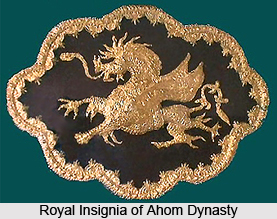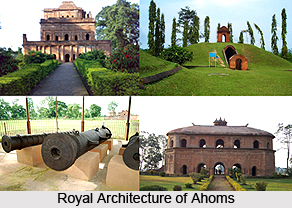 Suklingphaa is also known as `Kamaleswar Singha` and was an ancient ruler of the kingdom of Ahom, particularly in the Indian state of Assam. He was famous for effectually suppressing the Moamoria Rebellion and reinstalling Ahom rule over the region of Upper Assam. Suklingphaa had also managed to curb the Dundiya Revolution in Kamrup. During his regime, the royal Ahom army had also emerged victorious against the Kacharis of Kachari empire and Moamoria rebels. The administration of the Ahom kingdom was then supervised by Purnananda Burhagohain since the ruler Suklingphaa was quite young during that point of time. It is believed that the wise political decisions of the Prime Minister Purnananda Burhagohain were responsible for the financial prosperity and military prowess of Ahom empire during the rule of Suklingphaa.
Suklingphaa is also known as `Kamaleswar Singha` and was an ancient ruler of the kingdom of Ahom, particularly in the Indian state of Assam. He was famous for effectually suppressing the Moamoria Rebellion and reinstalling Ahom rule over the region of Upper Assam. Suklingphaa had also managed to curb the Dundiya Revolution in Kamrup. During his regime, the royal Ahom army had also emerged victorious against the Kacharis of Kachari empire and Moamoria rebels. The administration of the Ahom kingdom was then supervised by Purnananda Burhagohain since the ruler Suklingphaa was quite young during that point of time. It is believed that the wise political decisions of the Prime Minister Purnananda Burhagohain were responsible for the financial prosperity and military prowess of Ahom empire during the rule of Suklingphaa.
Suklingphaa or Kamaleswar Singha was the eldest son of Numali Rajmao and Kadamdighala Gohain, and was given the name of `Kinaram Gohain` by his parents. His father Kadamdighala Gohain was the younger brother of the Ahom ruler, Swargadeo Rudra Singha and the grandson of Prince Kadamdighala Gohain. Chandrakanta Singha, a brother and Maju Aideo who was a sister were the two siblings of Suklingphaa.
Suklingphaa`s Accession to the Throne
Kadamdighala Gohain was the Charingia Raja when Swargadeo Gaurinath Singha passed away during 1795 CE, at Jorhat. As Gaurinath Singha was devoid of a legitimate heir to the throne, he requested Purnananda Burhagohain to choose the new king of Ahom Dynasty. On account of friendship and as a sign of gratitude towards Prince Kadamdighala Gohain, Purnananda Burhagohain in suppressing the rebellion of Moamoria, the elder son of Kadamdighala Gohain named Kinaram Gohain was selected as the next king of Ahom Kingdom. That time, Kinaram was merely a two-year-old baby boy. Eventually, Swargadeo Kamaleswar Singha was proclaimed ruler of the sovereign of Ahom Kingdom, Assam during 1795 CE and was placed at the imperial throne of Assam, at Dichoi camp. The title of `Suklingphaa` was conferred on him by Tai-Ahom priests during his coronation. The name Kamleswar Singha was sent all the way to Kolkata for being punched on coins.
Reign of Suklingphaa
During the initial phase of the succession of Suklingphaa, the political situation of the nation was completely unstable. The Moamoria rebels continued to threaten communal peace and revolts from several portions of the kingdom spread like wildfire. The regional tribes of neighbouring hills started conducting regular raids in villages present in Brahmaputra Valley. Thereafter, innumerable Assamese people were compelled to retreat to Jaintia, Cachar, and British administered province of Bengal, and trace and commerce, agricultural activities were brought to an abrupt halt. Due to the financial constraints of the royal treasury and depleted state finances, the traditional coronation ceremony organised by the Tai-Ahom priests was postponed. During those olden days, the approximate expenditure incurred by such a ceremony amounted to 4, 00, 000 rupees. The royal scenario was quite gloomy since there was no dearth of disloyal officials who chose to support rebels and often proclaimed their independence from Ahom reign.

However, Prime Minister Purnananda Burhagohain resolved to solve this crisis and re-establish the lost glory of the Ahom Kingdom. Therefore, following Suklingphaa`s accession to the throne, he ensured that all the corrupt administrative officials were ousted from their offices. Instead, he persuaded the new ruler to permit him to appoint his closest relatives in positions which required trustworthiness and high responsibility. Purnananda Burhagohain invested all his time and energy towards introducing restoration in the empire. His reign witnessed the fierce rebellions of the Moamoria and Dafalas in the north bank of Brahmaputra.
Suklingphaa`s Re-Organising of Ahom Army
Prime Minister Purnananda Burhagohain was aware that a well-maintained and strong army which received regular pay was the pre-requisite of a prosperous empire. During the rule of the precious king named Gaurinath Singha, Purnananda had realized the significance of a well-organised British army which had defeated the Moamoria rebels. Thus began the remodelling of the Ahom army alongside the lines of British troops during the regime of Gaurinath Singha which continued even till the reign of Kamaleswar Singha. Purnananda Burhagohain released a formal embassy comprising Bhudhar Chalitha Changkakati, Baloram Khangia Phukan, Tanusyam Sarma Khound, Govindram Sarma Khound and Madhuram Bora under his son Orekhanath Dhekial Phukan`s leadership during 1803 CE, to Lord Wellesley, the Governor General of India along with a request to provide him some well-trained sepoys and a supply of weapons. 10, 000 silver rupees and 2000 gold `mohurs` were presented to Wellesley by the Ahom envoys. Purnananda`s request was readily accepted and the Ahom army was immediately organised following updated procedure utilizing local Assamese people from Dayang and Bacha areas who were all recruited in the Ahom army. They were all trained skilfully in the fields of modern warfare and weaponry with the aide of sepoys from British army. The Ahom army was divided into eighteen companies of a hundred soldiers each. Chandra Gohain was appointed the Army Captain and was finally promoted to the rank of a Major and then a Colonel.
However, due to the financial instability of the royal treasury, the king Suklingphaa was unable to pay the wages to the sepoys. The `Mahantas` or spiritual heads of Vaishnavite monasteries were asked to contribute about 4, 000 rupees which were collected from every monastery. The `Khataniars` were entrusted the responsibility to go about this task with the help of which the armies were paid their wages.
Dundiya Revolt in Kamrup
Violent uprisings occurred meanwhile in Kamrup which was fuelled by faulty administration of Badan Chandra Borphukan, the then viceroy of Guwahati and Lower Assam who along with his officials teased the Lower Assam inhabitants as `Dhekeri` due to their dialect. The locals complained to Suklingphaa and his Prime Minister Purnananda Burhagohain against the constant insults hurled by their viceroy. However, at that time Suklingphaa and his officials were deeply engaged in putting down the Moamoria rebellion and consequently failed to pay heed to their grievances. Hindustani, Punjabi and Kachari tribes were assembled by Bir Datta Choudhary and Har Datta Choudhary who asserted their independence from Ahom rule in North Kamrup.
Numerous people assisted the Choudhury brothers, after which North Kamrup was brought under their control, with some help from Koch rulers of Bijni and Cooch Behar. The rebels were called `Dundiyas` by some historians who imply people who fight over petty issues. As Badan Chandra Borphukan was incapable of controlling the revolt, Kalia Bhomora was appointed the new Borphukan of Guwahati. The new viceroy Kalia Bhomora assembled soldiers of Raja of Dimarua and Raja of Beltola apart from some local troops to suppress the rebellion.
Death of Suklingphaa
A severe epidemic disease of small-pox broke out in the area of Jorhat and the neighbouring villages took place during January 1811 CE. The inhabitants of Jorhat started suffering and were prevented from visiting the residences of their own friends, relatives and well-wishers during their illnesses. Unfortunately, the young king Suklingphaa caught this ailment and consequently died. He was aged only 16 during the time of his death. After his death he was succeeded by Chandrakanta Gohain, his brother.



















